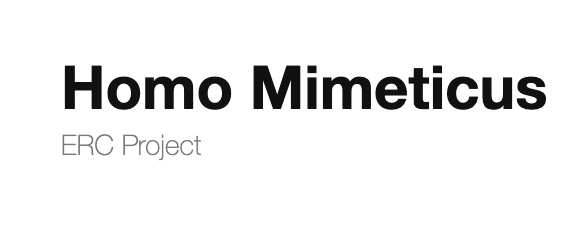
Located at the juncture of philosophy and the arts, mimesis is one of the most ancient concepts of literary theory and may not initially appear new, let alone original. It was indeed marginalized and forgotten in the Romantic and modernist periods haunted by the myth of originality. Yet, in recent years, scholars across the humanities, social sciences, and even the neurosciences, have returned to the ancient, yet strikingly contemporary, realization that humans are an imitative species, or homo mimeticus (www.homomimeticus.eu).
Taking the study of all too human, posthuman, and nonhuman forms of imitation beyond its traditional confines within aesthetic realism and mimetic desires, influential figures in continental philosophy (Nancy, Malabou), literary theory (Miller), feminism (Cavarero, Butler), political theory (Connolly), New Materialism (Bennet), posthuman studies (Hayles), history of psychology (Borch-Jacobsen), the neurosciences (Gallese) and more, have joined forces across disciplines to promote a “mimetic (re-)turn” attentive to the relational, embodied, plastic, contagious, resonant, and mirroring (im)properties of a chameleon species (see for instance Homo Mimeticus and Homo Mimeticus II).
The goal of this special issue of Trópos is to engage productively, critically and creatively with the mimetic (re-)turn to both deepen and further the transdisciplinary field of mimetic studies. Please take a moment to familiarize yourself with this field via the links above first as we look for contributions that are positioned within mimetic studies. We are especially interested in the contemporary conceptual masks of mimesis that enable us to further explore the two “faces” of mimesis that go beyond good and evil: understood as a vibrant affect that destabilizes the boundaries of individuation, mimesis on the one hand generates life-negating pathologies and, on the other hand, produces life-affirmative patho-logies. We welcome contributions to new mimetic studies across different disciplines and theoretical schools, including but not limited to:
- Modernist mimesis (phantom egos, homo duplex, crowd behavior)
- Mimicry, interculturality, decolonization
- Postmodernist mimesis (pastiche, intertextuality, simulation)
- Mimesis in postcritique & affect theory (identification, apprehension, attunement)
- (New) fascist mimesis (myth, disinformation, post-truth)
- Mimetic posthumanism (hypermimesis, AI simulations, homo mimeticus 2.0)
- After post-poststructuralist mimesis (Derrida, Irigaray, Lacoue-Labarthe, Nancy, Lawtoo)
- Mimicry after Critical Theory (Benjamin, Adorno, Fromm, Jameson)
- Hermeneutics and Mimesis (Heidegger, Gadamer, Vattimo)
- New materialist mimesis (contagion, influx & efflux, entangled humanism, “flesh”)
- Gendered mimesis & mimetic inclinations (Irigaray, Butler, Cavarero, Ahmed)
- Mimetic resonance (Rosa)
- Imitation & neuroscience (mirror neurons, plasticity, epigenetic mimesis)
- Mimesis and (literary) selfhood (life writing, autofiction, relating narratives, autotheory)
- Suggestive mimesis (mimetic unconscious, hypnosis, empathy, influence)
- Biomimicry and metamorphosis (beyond human/nonhuman mimesis)
-Word length 7.500 words max, including footnotes; 200 words abstract (in English); 5-6 keywords.
-On a separate sheet: author's name, affiliation, email and a short bio (50-60 words)
-Style, we might have to adapt it but for the moment follow Chicago Style (footnotes and bibliography):
https://www.chicagomanualofstyle.org/tools_citationguide/citation-guide-1.html
-Language: English is preferred but French, Italian, and Spanish are also possible
-Submit to: n.lawtoo@hum.leidenuniv.nl and m.a.peters@hum.leidenuniv.nl
-For more information visit Tropos' website: https://ojs.unito.it/index.php/tropos/Norme